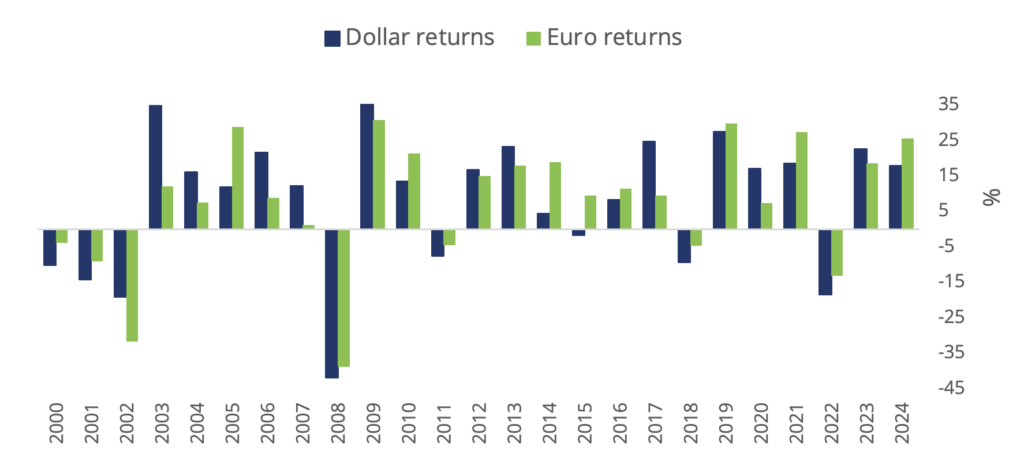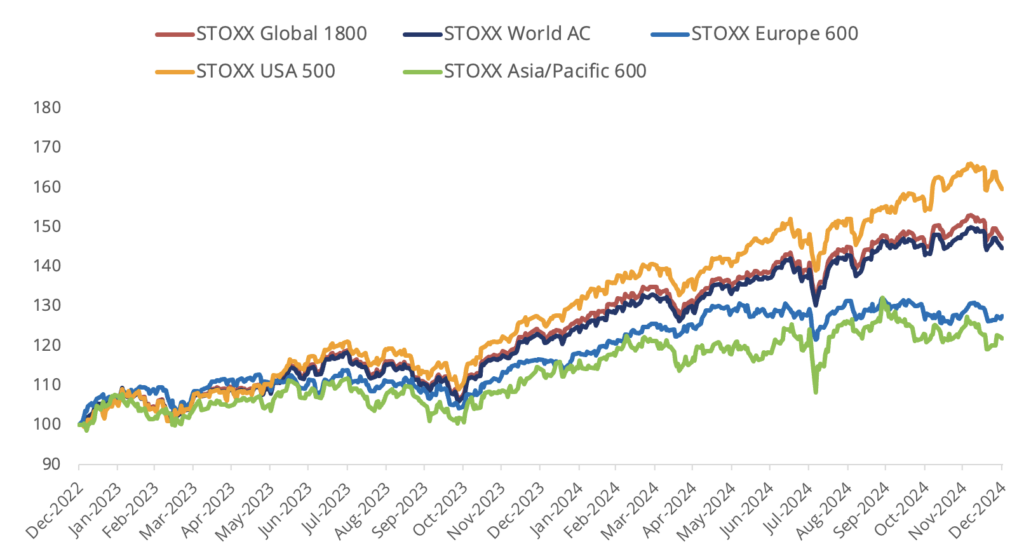Stocks dropped in December, paring global indices’ double-digit returns in 2024.
The STOXX® World AC fell 2.2% last month when measured in US dollars and including dividends, taking its 2024 gain to 17.9%. The global benchmark added 25.7% in euros over the year as the greenback climbed 6.3% against the common currency. The STOXX® Global 1800 index lost 2.7% in December and rose 18.8% in 2024.
The Eurozone’s EURO STOXX 50® added 1.9% in euros in December on a total-return basis (11.9% for 2024).[1] The pan-European STOXX® Europe 600 fell 0.4% (+9.5%). The STOXX® North America 600 slid 2.9% in dollars (+24.8%) while the STOXX® USA 500 lost 2.8% (+25.5%). The STOXX® Asia/Pacific 600 shed 1.9% in dollars (+6.4%). The STOXX® Developed World slid 2.5% (+19%) and the STOXX® Emerging Markets fell 0.2% (+8.5%).
Figure 1: STOXX Equity World indices’ December risk and return

Source: STOXX. Gross returns. Data as of December 31, 2024.
Figure 2: STOXX Benchmark indices’ December risk and return

Source: STOXX. Gross returns. Data as of December 31, 2024.
Germany’s DAX® increased 1.4% in the month. MDAX®, which gauges the performance of German mid-caps, fell 2.8%.
Figure 3: DAX indices’ December risk and return

Source: STOXX. Gross returns. Data as of December 31, 2024.
| For a complete review of all indices’ performance last month, visit our December index newsletter. |
Rates and inflation
December failed to match this year’s enthusiasm among investors that falling interest rates and technological breakouts will propel corporate earnings higher. On December 19, the Federal Reserve cut the key US interest rate by 25 basis points but signaled to future rate cuts that were slower than anticipated by the market, and increased its prediction for inflation in 2025.
Figure 4: Total annual % returns for STOXX World AC index

Source: STOXX. Gross returns.
Figure 5: Select STOXX benchmarks’ returns since 2023

Source: STOXX. Gross returns in dollars except for STOXX Europe 600 Index, which is in euros. Data from December 30, 2022, to December 31, 2024.
Volatility mixed
The VSTOXX® (EURO STOXX 50® Volatility), which tracks the price of EURO STOXX 50 options traded on Eurex, ended December unchanged from November at 17. A higher VSTOXX reading suggests investors are paying up for puts that offer insurance against stock price drops. The VDAX®, which measures volatility in German equities, rose to 15.6 from 14.6 a month earlier.
Factor investing
Among the STOXX Factor indices, the Momentum signal led losses last month although the strategy performed the best in the suite over the entire year, returning 46.7%. (Figure 6).
Figure 6: STOXX Factor (Global) indices’ December risk and return characteristics

Source: STOXX. Gross returns. Data as of December 31, 2024.
Climate benchmarks
Within climate benchmarks , the STOXX® Global 1800 Paris-Aligned Benchmark (PAB) fell 1.7% and the STOXX® Global 1800 Climate Transition Benchmark (CTB) dropped 2%. The PAB and CTB indices follow the requirements outlined by the European Commission’s climate benchmarks regulation.
Sustainability indices
The STOXX® Global 1800 ESG-X index slid 2.5% in the month. The STOXX® ESG-X indices are versions of traditional, market capitalization-weighted benchmarks that observe standard responsible exclusions.
The DAX® ESG Screened rose 1.1% in the month. The index reflects the composition of the DAX benchmark minus companies that fail to pass norms-based and controversial weapons screenings, meet minimum ESG ratings or are involved in certain business activities considered undesirable from a responsible investing perspective.
Within indices that combine exclusions and best-in-class ESG integration, the EURO STOXX 50® ESG index rose 1.7% over the month. Germany’s DAX® 50 ESG index (+1.1%)[2], which excludes companies involved in controversial activities and integrates ESG scoring into stock selection, lagged behind the benchmark DAX in the month.
The STOXX® Global 1800 SRI fell 2%. The STOXX SRI indices apply a set of carbon emission intensity, compliance and involvement screens, and track the best ESG performers in each industry group within a selection of STOXX benchmarks.
Thematics, digital assets
Seventeen of 40 STOXX® Thematic indices outperformed the benchmark STOXX Global 1800 last month. The STOXX® Europe Luxury 10 index (+5.7%) showed the biggest gain, while the STOXX® Global Lithium Miners and Producers index (-15.2%) led losses.
The STOXX® Digital Asset Blue Chip index, which aims to track high-quality assets that represent the crypto universe today, fell 5.1% in the month.
Dividend strategies
Dividend strategies also showed losses in the month that ended. The STOXX® Global Maximum Dividend 40 (-1.9% on a net basis) selects only the highest-yielding stocks. The STOXX® Global Select Dividend 100 (-3.3%) tracks companies with sizeable dividends but also applies a quality filter such as a history of stable payments.
Minimum variance
Minimum variance strategies in the US had a weak month relative to benchmarks in December. The STOXX® Global 1800 Minimum Variance fell 4.5% and the STOXX® Global 1800 Minimum Variance Unconstrained retreated 4.1%.
The STOXX Minimum Variance Indices come in two versions. A constrained version has similar exposure to its market capitalization-weighted benchmark but with lower risk. The unconstrained version, on the other hand, has more freedom to fulfill its minimum variance mandate within the same universe of stocks.
1 Throughout the article, all European indices are quoted in euros, while global, North America, US, Japan and Asia/Pacific indices are in US dollars.
2 Figures in parentheses show last month’s gross returns.
